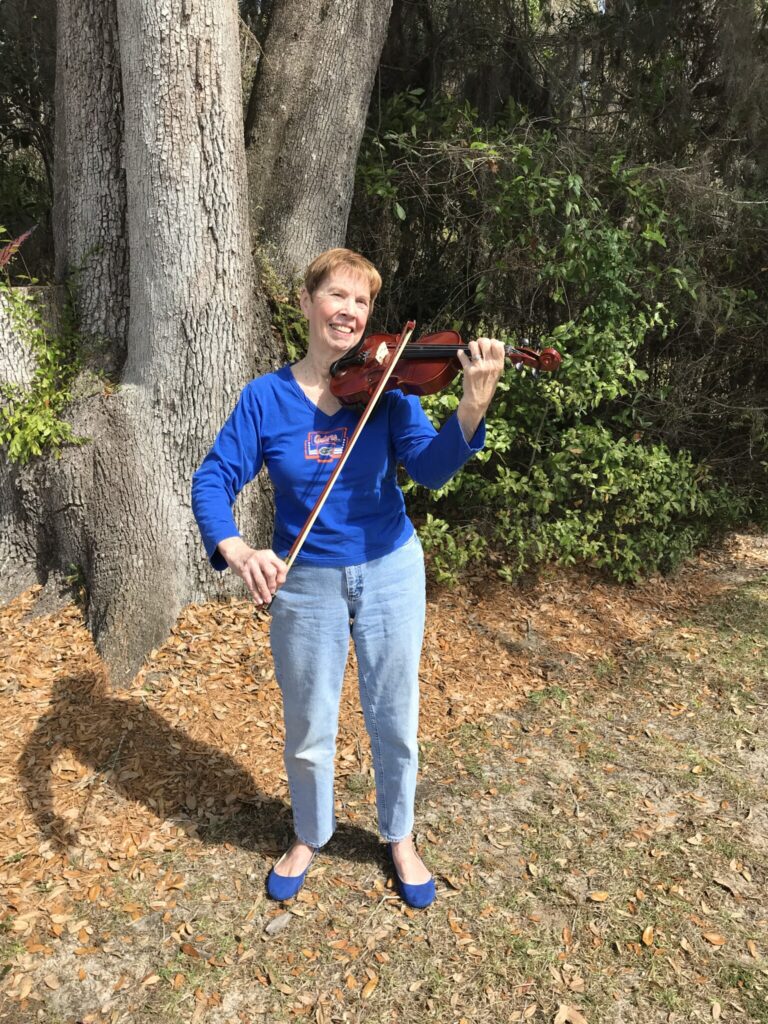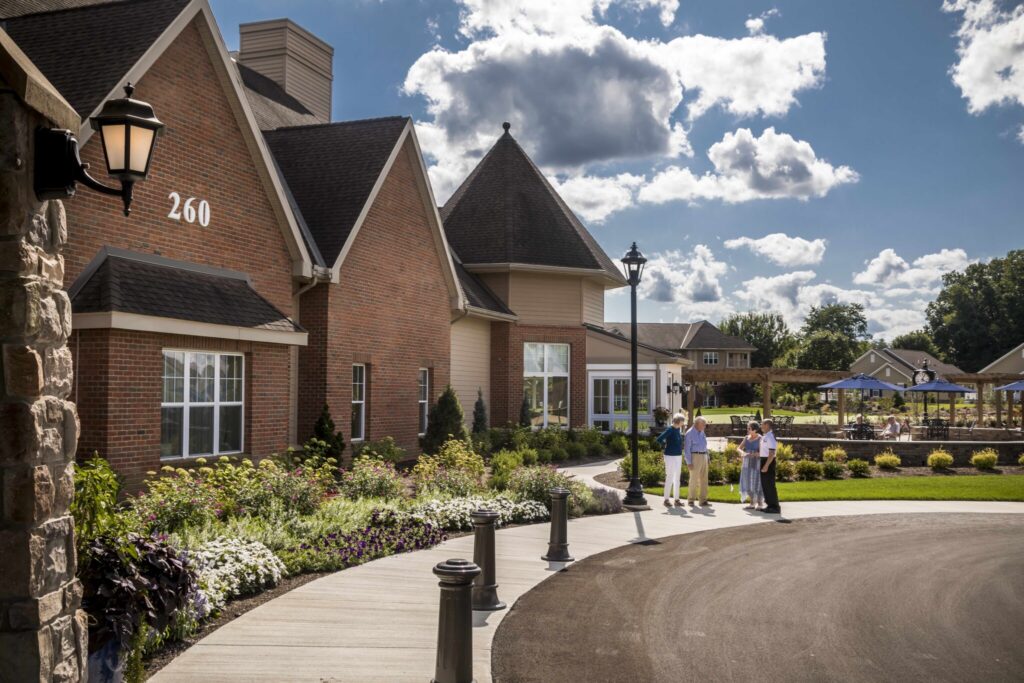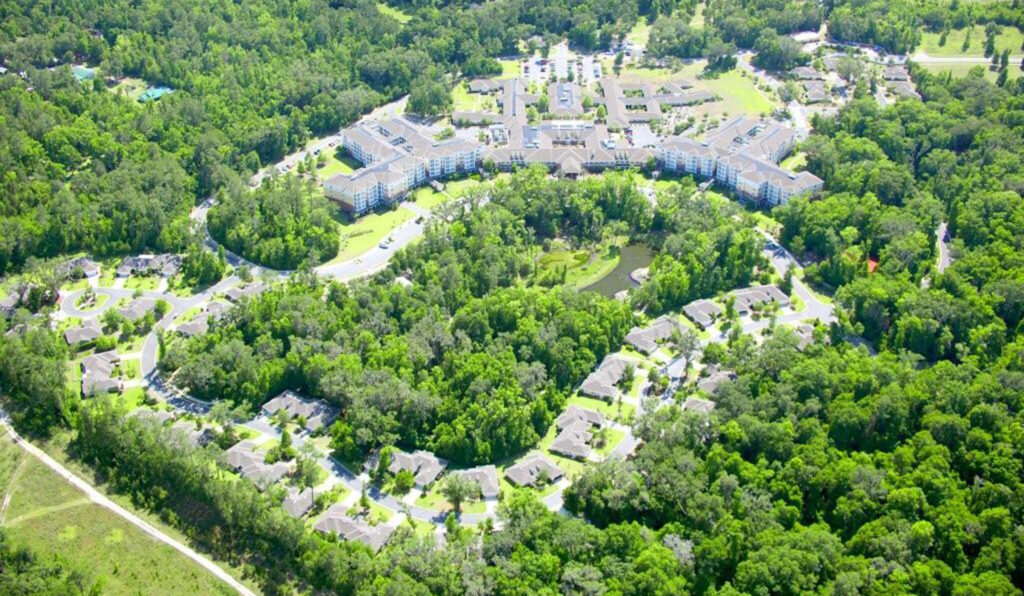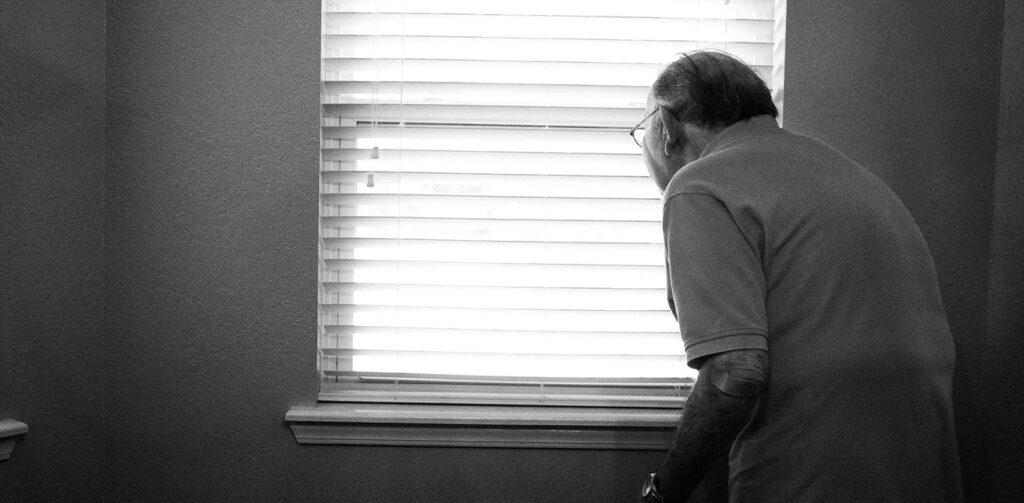Retirees Enticed by Campus Life
Patsy and Warren Nelms met and married while undergraduates at the University of Florida in the 1950s and raised two Gators. So when they decided to move to a retirement community, the choice was clear: Oak Hammock at the University of Florida.
Located a mile from UF’s southern edge, Oak Hammock offered them campus access, interesting, accomplished neighbors (nearly half are fellow alumni), and opportunities to interact with UF students — all part of the vision when UF spearheaded the development in the late 1990s.
The couple — she a retired educator and he an engineer who built an energy-efficient ‘smart’ house before that was a thing — became Oak Hammock residents in 2012. When Warren Nelms’ dementia progressed, he moved to the memory care unit, then to the skilled nursing center.
“This place has so much to offer and excellent health care; the fact that it’s connected to UF has been a big plus,” said Patsy Nelms, who visits her husband several times a day.

As the U.S. ages — about 10,000 people a day turn 65, and by 2030, one in five residents will be 65 and older — universities and colleges across the nation have connected with retirement developments geared toward well-heeled older adults who want access to lifelong learning, security and a vibrant community.
About 100 retirement communities across the U.S. claim to have some connection to a university, said Andre Carle, an expert in senior living administration. They run the gamut from 55 and older subdivisions with loose ties to a nearby university, to full-service continuing care retirement communities (CCRCs) strongly linked with their partner schools.
Carle said no more than four dozen of those have a significant enough connection to be called a university-based retirement community (UBRC). He coined the term in 2004 and developed five criteria to better define this variation on senior housing.
Under Carle’s model, a UBRC is a CCRC (which typically includes independent housing, assisted living, a skilled nursing facility, and a memory loss center to accommodate changing needs as residents age) within a mile or so of campus that has formal programming arrangements with the university. The community is not university-run but there is a financial relationship between the two entities. At least 10% of residents are some mix of alumni, relatives of alumni, and retired faculty and staff.
“That’s what brings the university culture to it,” Carle said. To qualify as a UBRC, a development must meet at least three of those criteria, he said.
In spite of the COVID-19 pandemic, which forced universities and colleges to switch to distance learning in the spring and will limit campus life at many institutions this fall, Carle anticipates the senior living industry will only experience a short-term slowdown. The estimated 8 million baby boomers — people born between 1946 and 1964 — begin turning 75 next year, and the current supply of retirement housing cannot meet the demand, he said. Significant growth in the industry may begin in as early as three to five years, Carle said.
“With the next generation of retirees still focused on active, intellectually stimulating, and intergenerational retirement environments, UBRCs could represent a more appealing model than ever before,” he said.
Big-name institutions, including Duke University, Stanford University, University of Michigan, Cornell University, University of Alabama, Pennsylvania State University, University of Notre Dame, and a number of University of California campuses, are among those that have true UBRCs.
A Benefit, Not a Panacea
UBRCs can boost university revenue through land leases, shared services and, ideally, increased donations. Oak Hammock estimated that residents have donated $50 million to the UF since opening in 2004. UF spokesman Luke Anderson said he could not comment on the amount, as the university keeps donor records and information confidential.
But UBRCs are no panacea for institutions facing lower enrollment of traditional college students, Carle said. Last fall, college enrollment in the U.S. dropped for the eighth straight year, an 11% reduction since 2011, according to the National Student Clearinghouse Research Center.
“Will it put people in classroom seats to any significant degree? No,” Carle said. At both Oak Hammock and The Village at Penn State at Pennsylvania State University, only one resident was enrolled in a course on campus before classes switched to distance learning in March, spokeswomen for both communities said.
Residents often take classes through their community’s lifelong learning program, which draws instructors from the affiliated university and elsewhere. Some UBRCs have ties to a university’s lifelong learning center, which offers a wide range of noncredit classes to older adults.
UBRC benefits are plentiful. Gung-ho UBRC residents can “become fans of the university sports teams, and audience members for performing arts,” Carle said. The community creates jobs and internships for students, and residents are often willing to participate in mentorships and university research projects. It also provides a place for longtime faculty and staff to retire.
“All those little pieces added together can make a difference, and create a nice ancillary business partnership,” Carle said. He created both undergraduate and graduate curricula in senior living administration and teaches Georgetown University’s graduate program. His day job is running The Virginian, a 300-unit retirement community in Fairfax, Virginia.
Carle said he gets calls from small rural colleges excited by the success of the 2,100-student LaSell University’s partnership with LaSell Village in Massachusetts. Located on the LaSell University campus about 12 miles outside downtown Boston, the retirement community has a large pool of academically minded professionals to draw from. It’s also near professional and collegiate sports teams, museums, performing arts, and historic sites, which increase its desirability, he said.
“You can’t have the ‘build it and they will come’ mentality,” he warned. “Small, remote universities that are struggling may think this is going to save them, but some don’t have the characteristics to make it successful.”
Village at Penn State
Even UBRCs affiliated with large universities can struggle. The Village at Penn State, located on 50 acres of university property a mile from the Penn State campus, filed for bankruptcy in 2011, eight years after opening. The nonprofit Liberty Lutheran took ownership in 2012 and the 240-resident community has flourished. Roughly 75% of residents are either alumni, retired faculty or staff, or have some other university connection, Executive Director Ellen Corbin said.

Issued Penn State ID cards, residents can audit Penn State courses and use campus libraries and golf courses. Residents also can take classes through the campus’ Osher Lifelong Learning Institute, Director of Resident Services Kimberly McGinnis said. (Many residents took advantage of online Osher classes during Pennsylvania’s stay-at-home order, McGinnis said.)
Sporting events are a big deal in College Park, and the UBRC provides transportation to them.
When Penn State football coach James Franklin calls for a Happy Valley ‘White Out’ for Nittany Lions home games, residents and staff dress in white and send photos to the coach’s Twitter account. “We have fun with it!” Corbin said.
Residents, who range in age from their late 60s to 101, pay an entry fee ranging from $184,000 to $497,000. Monthly fees cost between $3,471 and $5,985 (for couples, the second person pays $1,254 a month), Corbin said. The university receives income through the land lease and name licensing agreement, she said.
Residents who moved in when Pennsylvania’s stay-at-home order was in effect had to quarantine for two weeks, McGinnis said. All gatherings except for socially distanced, mask-wearing fitness classes, were suspended, and meals were delivered to residents’ rooms, McGinnis said.
To help residents cope with isolation, McGinnis shared online opportunities in learning and entertainment, and hosted rolling cart happy hours and an ice cream social. Bagpipers walked outside the residence in March, and residents organized group orders of groceries, which the Village at Penn State staff delivered, she said. One resident used the time to complete a fundraiser to mark his 83rd birthday: he rode his bicycle 830 times around a loop on the property, traveling nearly 500 miles between April and June, McGinnis said. He donated the $4,800 he raised to a local YMCA providing lunches for children.
“It was certainly a hard time, but we got through it,” she said.
‘Textbook Example’ at ASU
While some UBRCs developed organically, the 20-story Mirabella at Arizona State University in Tempe has been designed to meet the criteria, what Carle calls a “textbook example.” (He is not affiliated with the project.) Mirabella at ASU is set to open by year’s end on the campus’ northwest corner, and almost all of its 252 independent living apartments are sold, said Lindsey Beagley, director of Lifelong University Engagement for the Mirabella at ASU.
An ASU-affiliated nonprofit, University Realty, is involved in construction of the $296 million project with Pacific Retirement Services, the nonprofit that will operate the Mirabella, Beagley said. The university received $7 million upfront for leasing the 1.9 acres. Under a 99-year lease agreement, ASU will receive about $500,000 a year annually in lieu of property taxes, Beagley said.
Randy and Sharon Fortenberry of Socttsdale, Arizona, are eager to move into their 13th-floor apartment in November. They plan to take ASU classes in painting and Spanish, and serve as mentors to undergraduates.

“It’s wonderful to interact with young people,” Randy Fortenberry said. “It’s exciting for us, and I think it will be for them.”
The Fortenberrys are retired Washington State public school principals who founded and ran an education center while living five years in central Mexico, he said. When the couple returned to the U.S., he earned a degree in psychotherapy. Fortenberry was far older than his classmates, and “loved the experience.” The 76-year-old retired from practice after nine years, he said.
They admire their fellow incoming residents, successful professionals who remain curious. “It’s not your typical retirement community,” Fortenberry said. Only about 30% of Mirabella at ASU residents had a prior tie to the university, Beagley noted.
Another draw of Mirabella at ASU is health care, Fortenberry said. The couple can receive in-home care should they need it, and will have access to its assisted living, acute skilled nursing, and a memory care facility in the building. They do not want the experience their mothers had of moving to different facilities as their health deteriorated.
Mirabella at ASU entrance fees start at $300,000 and can exceed $1 million depending on each unit’s size, location, and customization, Beagley said. Monthly fees that cover meals, activities, the health club, cleaning services, transportation, and the community’s extensive lifelong learning program range from $4,195 to $6,321 for individuals; a second resident in a unit pays $1,088 a month, Beagley said. When residents die, 85 to 90% of their entry fee is refunded to their estate.
Three ASU performing arts students will live at Mirabella at ASU in exchange for performing five evenings a week in the lounge, Beagley said. The project will create 200 full-time positions, as well as 70 part-time jobs that are expected to attract students, she said.
Beginning with the spring 2021 semester, residents will be able to choose from a curated list of ASU courses and join the 50,000 students on the Tempe campus, Beagley said. They’ll receive ASU identification cards to use at campus libraries and gyms, and get discounts at book stores. They’ll also get complimentary tickets to some sporting events and performances.
For now, incoming residents are taking part virtually in online ASU offerings, including monthly faculty lectures, conferences, and student performances, Beagley said. Those who currently don’t live near Tempe are also able to participate in social events through video conferencing. “It’s allowed folks moving from out-of-state to get involved,” she said.
‘So Much Talent Here’
Back at Oak Hammock, Patsy Nelms keeps busy. The 82-year-old edits the community’s newspaper, belongs to a book club, gardens and plays the violin and fiddle. (The Oak Hammock Fiddlers rehearsed in her house until the group got too big.)
Nelms said Oak Hammock has kept residents well-informed during the pandemic. “I feel safe here. Everyone is wearing masks and social distancing,” she said. Her book club recently resumed in-person meetings.

The Nelms paid an entry fee of $364,100 for a three-bedroom home eight years ago and are charged a monthly fee of $5,776, an amount that did not increase when Warren Nelms required nursing care, she said.
Nelms has taken pilates classes, and art and academic courses through the community’s robust Institute for Learning in Retirement, taught by professors from UF, the local community college, and Oak Hammock residents themselves.
“There’s so much talent here,” Oak Hammock Director of Community Services Catherine Osman said.
In normal times, the 560 residents have plenty of opportunities to engage with UF students. The fitness center, run by a UF alum, is staffed by College of Health and Human Performance students fulfilling their practicums. Pharmacy students review residents’ medications, while engineering students run ‘tech tuneup’ sessions, helping residents figure out how to fix or use their technology, Osman said.
Residents, meanwhile, volunteer to help international students practice English and take part in university studies. A retired UF dean of music residing at Oak Hammock arranged for UF musicians to play at the community and get feedback from residents in preparation for graded performances.
“With the benefits flowing both ways, it seems to me that this partnership between Oak Hammock and the University of Florida is a model for healthy society around our nation,” UF President W. Kent Fuchs said at Oak Hammock’s 15th anniversary celebration in December.
Jamie Alexander, a UF senior last semester, said she hadn’t spent much time around seniors before doing an internship at Oak Hammock’s sales and marketing department. Alexander’s responsibilities included interviewing residents for social media.
“They are some of the most interesting people, and they’re so open to sharing career and life advice,” said the 22-year-old, who double-majored in advertising and English. “I’ve learned to be more of a listener.”
Patsy Nelms, who always has homemade peppermint ice cream on hand to share, can’t imagine living anywhere else. Having UF in common with fellow residents “raises the level of interactions and conversations. There are lots of connections. This is ideal for me.”
Margaret McHugh worked 20 years as a newspaper reporter before launching an independent career, largely promoting nonprofits. Margaret writes for Rutgers University Division of Continuing Studies and other Rutgers’ entities. She has produced and edited content for the ACLU of New Jersey and the New Jersey State Bar Association. She shares a home office with two rescue dogs, Ellie and Emma.

